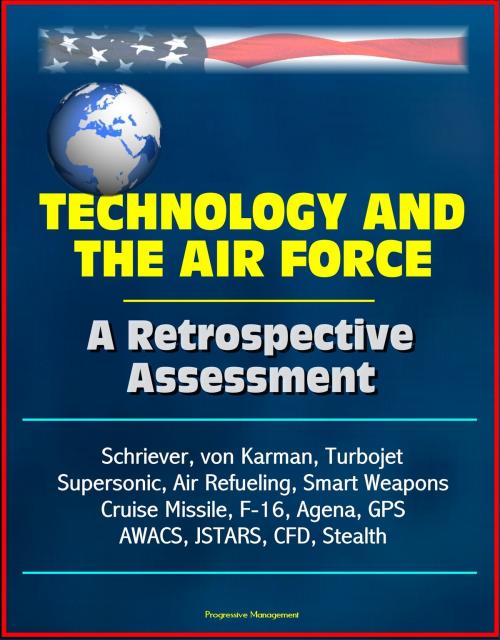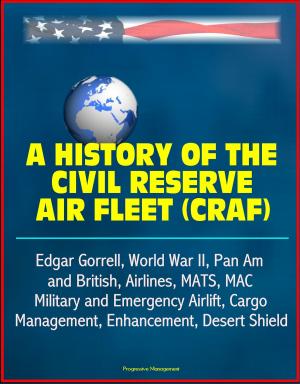Technology and the Air Force: A Retrospective Assessment - Schriever, von Karman, Turbojet, Supersonic, Air Refueling, Smart Weapons, Cruise Missile, F-16, Agena, GPS, AWACS, JSTARS, CFD, Stealth
Nonfiction, Science & Nature, Technology, Aeronautics & Astronautics, History, Military, Aviation| Author: | Progressive Management | ISBN: | 9781310067235 |
| Publisher: | Progressive Management | Publication: | August 11, 2015 |
| Imprint: | Smashwords Edition | Language: | English |
| Author: | Progressive Management |
| ISBN: | 9781310067235 |
| Publisher: | Progressive Management |
| Publication: | August 11, 2015 |
| Imprint: | Smashwords Edition |
| Language: | English |
Professionally converted for accurate flowing-text e-book format reproduction, this fascinating Air Force publication takes a good look at the history of aerospace technology ranging from the turbojet revolution of the 1930s to the stealth revolution of the 1990s. The history of the United States Air Force is inextricably bound up in the history of aerospace technology. Major revolutions have influenced the evolution of Air Force capabilities and systems, most notably those of atomic weaponry, the turbojet revolution, supersonic flight, avionics, aerial refueling, spaceflight, precision weaponry, electronic flying controls, composite materials, and stealth. It is worthwhile to take a retrospective look at some of the aerospace challenges and opportunities the Air Force faced and how it took advantage — or failed to take advantage — of them.
With this in mind, the Air Force History and Museums Program organized a symposium in which leading historians, technologists, and military decisionmakers met at Andrews Air Force Base, Maryland, to present case studies on a series of technological challenges, opportunities, and problems. This volume presents the texts of the papers in the order they were given.
Riding England's Coattails: The Army Air Forces and the Turbojet Revolution * James O. Young * Technological Forecasting and the Air Force * Michael H. Gorn * The Air Force and the Supersonic Breakthrough * Richard P. Hallion * The Origins of Air Refueling in the United States Air Force * Thomas A. Julian * Technology and Doctrine * I. B. Holley, Jr. * Ace in the Hole: The Air Force Ballistic Missiles Program * Jacob Neufeld * Stretching the Rubber Band: Smart Weapons for Air-to-Ground Attack * David R. Mets * The USAF and the Cruise Missile: Opportunity or Threat? * Kenneth P. Werrell * Blind Faith: The United States Air Force and the Development of Fly-By-Wire Technology * James E. Tomayko * The New Calculus Revisited * Fredrick L. Frostic * Nuclear-Powered Flight * Barton C. Hacker * The F-16 Lightweight Fighter: A Case Study in Technology Transition * David C. Aronstein and Albert C. Piccirillo * The Air Force Agena: A Case Study in Early Spacecraft Technology * R. Cargill Hall * Origins of the Global Positioning System * George W. Bradley III * The Space Revolution * Thomas S. Moorman, Jr. * AWACS and JSTARS * George K. Williams * Computational Fluid Dynamics * John D. Anderson, Jr. * Low Observables: the Air Force and Stealth * Paul G. Kaminski * Information Systems and Applications * Carl O' Berry * Summation * Richard P. Hallion
Riding England's Coattails: The Army Air Forces and the Turbojet Revolution -
In 1928, twenty-one-year-old Royal Air Force flight cadet Frank Whittle speculated that it would be possible to attain very high speeds — speeds in excess of 500 mph — if one could achieve stratospheric flight. He also perceived that the piston-engined, propeller-driven airplane would never do the job. To achieve the speed and altitude he envisioned, some alternative form of propulsion system uniquely suited to those conditions was essential. His deductions were prophetic. During the 1930s, the prop-driven, piston-engined airplane underwent a dramatic metamorphosis. Streamlined, all-metal, light-weight, monocoque fuselages, retractable landing gear, and a host of other airframe innovations reduced aircraft weight and drag to previously unimagined levels. And the engines? The Wright Brothers had powered their first airplane with an engine providing about 12 horsepower — or one horsepower per 15 pounds of engine weight.
Professionally converted for accurate flowing-text e-book format reproduction, this fascinating Air Force publication takes a good look at the history of aerospace technology ranging from the turbojet revolution of the 1930s to the stealth revolution of the 1990s. The history of the United States Air Force is inextricably bound up in the history of aerospace technology. Major revolutions have influenced the evolution of Air Force capabilities and systems, most notably those of atomic weaponry, the turbojet revolution, supersonic flight, avionics, aerial refueling, spaceflight, precision weaponry, electronic flying controls, composite materials, and stealth. It is worthwhile to take a retrospective look at some of the aerospace challenges and opportunities the Air Force faced and how it took advantage — or failed to take advantage — of them.
With this in mind, the Air Force History and Museums Program organized a symposium in which leading historians, technologists, and military decisionmakers met at Andrews Air Force Base, Maryland, to present case studies on a series of technological challenges, opportunities, and problems. This volume presents the texts of the papers in the order they were given.
Riding England's Coattails: The Army Air Forces and the Turbojet Revolution * James O. Young * Technological Forecasting and the Air Force * Michael H. Gorn * The Air Force and the Supersonic Breakthrough * Richard P. Hallion * The Origins of Air Refueling in the United States Air Force * Thomas A. Julian * Technology and Doctrine * I. B. Holley, Jr. * Ace in the Hole: The Air Force Ballistic Missiles Program * Jacob Neufeld * Stretching the Rubber Band: Smart Weapons for Air-to-Ground Attack * David R. Mets * The USAF and the Cruise Missile: Opportunity or Threat? * Kenneth P. Werrell * Blind Faith: The United States Air Force and the Development of Fly-By-Wire Technology * James E. Tomayko * The New Calculus Revisited * Fredrick L. Frostic * Nuclear-Powered Flight * Barton C. Hacker * The F-16 Lightweight Fighter: A Case Study in Technology Transition * David C. Aronstein and Albert C. Piccirillo * The Air Force Agena: A Case Study in Early Spacecraft Technology * R. Cargill Hall * Origins of the Global Positioning System * George W. Bradley III * The Space Revolution * Thomas S. Moorman, Jr. * AWACS and JSTARS * George K. Williams * Computational Fluid Dynamics * John D. Anderson, Jr. * Low Observables: the Air Force and Stealth * Paul G. Kaminski * Information Systems and Applications * Carl O' Berry * Summation * Richard P. Hallion
Riding England's Coattails: The Army Air Forces and the Turbojet Revolution -
In 1928, twenty-one-year-old Royal Air Force flight cadet Frank Whittle speculated that it would be possible to attain very high speeds — speeds in excess of 500 mph — if one could achieve stratospheric flight. He also perceived that the piston-engined, propeller-driven airplane would never do the job. To achieve the speed and altitude he envisioned, some alternative form of propulsion system uniquely suited to those conditions was essential. His deductions were prophetic. During the 1930s, the prop-driven, piston-engined airplane underwent a dramatic metamorphosis. Streamlined, all-metal, light-weight, monocoque fuselages, retractable landing gear, and a host of other airframe innovations reduced aircraft weight and drag to previously unimagined levels. And the engines? The Wright Brothers had powered their first airplane with an engine providing about 12 horsepower — or one horsepower per 15 pounds of engine weight.















